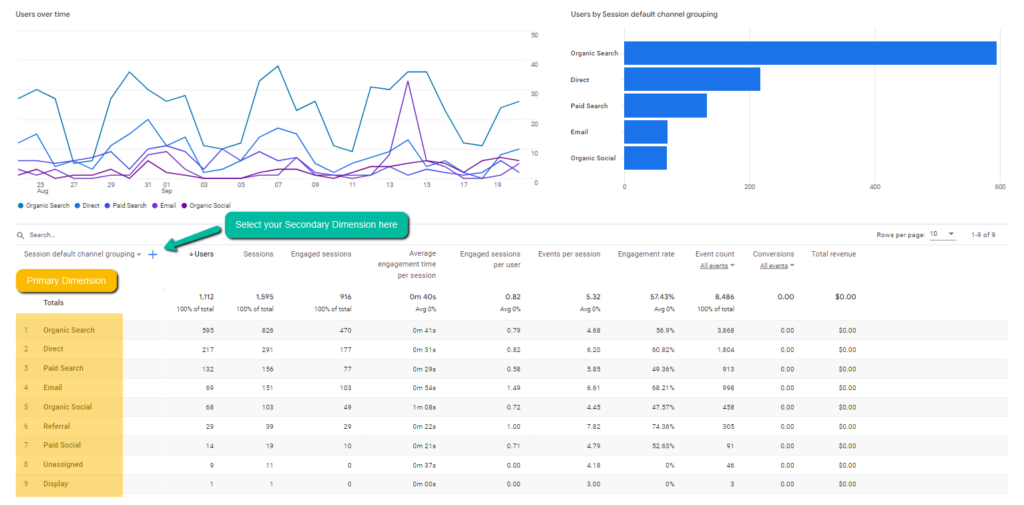Unlock Deeper Insights With Additional Measurement in Google Analytics
With the vast stretch of data readily available in Google Analytics, the utilization of additional measurements can dramatically enhance your logical capacities. These additional layers of information offer a nuanced perspective that can illuminate intricate details within your primary metrics. By tactically including additional dimensions into your evaluation, you can unearth valuable insights that could otherwise remain undiscovered. The capability to interpret and divide customer habits with greater precision opens up a world of possibilities for maximizing techniques and improving efficiency.
Understanding Main Vs. Second Measurements
On the various other hand, second dimensions enable you to more explore your main dimension information. By including a secondary measurement, you can layer on added information to your main measurement, making it possible for an extra granular evaluation. If your primary dimension is the source/medium with which individuals showed up on your site, including a secondary measurement like geographic location can expose where those customers are situated geographically.
Making Use Of Second Dimensions Effectively
By incorporating second dimensions alongside primary measurements, marketers and analysts can dig much deeper right into the specifics of individual communications on their sites. Additional dimensions enable customers to section and filter key measurement information further, offering a more in-depth sight of user interactions, demographics, and habits.
Furthermore, second measurements allow customers to compare and contrast various data factors within a solitary report, facilitating a more comprehensive evaluation of user actions patterns. By leveraging secondary dimensions effectively, companies can uncover hidden understandings, enhance their advertising strategies, and enhance the total customer experience on their websites.
Discovering Typical Additional Measurement Combinations
To additionally evaluate individual behavior and fads in Google Analytics, it is valuable to discover usual mixes of additional measurements. Some common secondary dimension mixes that offer important understandings include assessing website traffic resources with customer locations to comprehend where site visitors are coming from geographically and how they discovered the site. Checking out individual actions metrics with second dimensions such as passions or demographics can assist in targeting specific audience segments a lot more successfully.
Using Secondary Dimension in Custom Reports
Utilizing second measurements in custom records enables an extra thorough analysis of data in Google Analytics, improving the depth of understandings acquired. When creating personalized records in Google Analytics, integrating additional dimensions can provide a more thorough view of just how different measurements interact with each other. This feature makes it possible for users to dive deeper right into their information and reveal useful connections that might not be immediately obvious.
By applying additional measurements in personalized reports, customers can obtain a much better understanding of their site or application website traffic. As an example, incorporating the key dimension of "source/medium" with the second measurement of "landing web page" can expose which landing web pages are executing best for website traffic coming from details sources. This insight can help marketers maximize their campaigns and enhance overall conversion rates.

Enhancing Data Visualization With Second Measurement
When discovering information in Google Analytics customized reports, integrating second measurements not only supplies an extra thorough evaluation but additionally enhances the graph of insights through data visualization. By including an additional measurement to your records, you can improve the means information is offered, page making it simpler to recognize patterns, fads, and connections within your web site's performance metrics.
Additional measurements can assist you segment your information better, permitting a deeper understanding of user habits and interactions on your site. When trying to separate particular variables that might impact your web site's efficiency., this improved degree of granularity can be especially useful.

Conclusion
In final thought, leveraging additional dimensions in Google Analytics enables an extra thorough analysis of data, bring about deeper understandings and more informed decision-making. Secondary Dimension in Google Analytics. By including additional layers of info to key data sets, experts and online marketers can reveal hidden fads, patterns, and connections that offer a granular sight of user behavior and communications. This enhanced level of insight enables optimization of campaigns and tailored techniques for certain audience sections, eventually improving performance and conversion rates
On the various other hand, secondary measurements allow you to more study your primary measurement information. By adding a second measurement, you can layer on added information to your key dimension, making it possible for a more granular evaluation. If your key dimension is the source/medium via which customers arrived on your site, adding a second dimension like geographical area can expose where those users are situated geographically. By incorporating secondary measurements alongside main measurements, marketing experts and analysts can dive deeper into the specifics of user interactions on their sites. my website Secondary dimensions permit individuals to sector and filter primary measurement information additionally, providing an extra comprehensive view of customer communications, demographics, and habits.